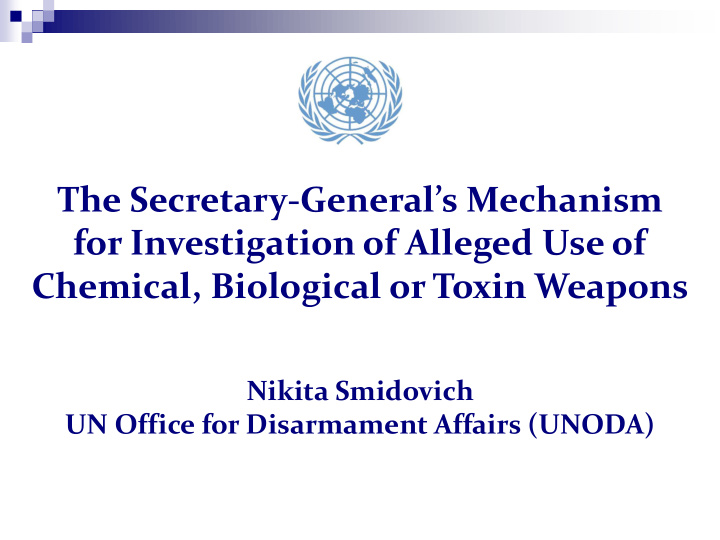



The Secretary- General’s Mechanism for Investigation of Alleged Use of Chemical, Biological or Toxin Weapons Nikita Smidovich UN Office for Disarmament Affairs (UNODA)
Legal Framework The complete and total prohibitions of use of chemical, biological and toxin weapons : o Geneva Protocol (Prohibition of the Use in War of Asphyxiating, Poisonous or Other Gases and of Bacteriological Methods of Warfare, signed in Geneva on 17 June 1925) o 1972 Biological Weapons Convention (BWC, EIF 1975) o 1993 Chemical Weapons Convention (CWC, EIF 1997) 2
SG Mandate General Assembly : Requests the Secretary-General to carry out promptly investigations in response to reports that may be brought to his attention by any Member State concerning the possible use of chemical and bacteriological (biological) or toxin weapons that may constitute a violation of the 1925 Geneva Protocol or other relevant rules of customary international law in order to ascertain the facts of the matter, and to report promptly the results of any such investigation to all Member States” (A/RES/42/37C (1987) Guidelines and Procedures (A/RES/44/561 (1989) Fact-finding 3
Security Council Support Security Council (Resolution S/RES/620 of 1988 ): o Encourages the Secretary-General to carry out promptly investigations in response to allegations brought to his attention by any Member State concerning the possible use of chemical and bacteriological (biological) or toxic weapons…….., in order to ascertain the facts of the matter, and to report the results o Decides to consider immediately, taking into account the investigations of the Secretary-General, appropriate and effective measures in accordance with the Charter of the United Nations, should there be any future use of chemical weapons in violation of international law, wherever and by whomever committed . 4
Recognition o Outcome Documents of the 2006 and 2011 Review Conferences of BWC: o “The United Nations Secretary - General’s investigation mechanism represents an international institutional mechanism for investigating cases of alleged use of biological or toxin weapons.” 5
SGM Basic Modalities o Any UN Member State can request an investigation by the UNSG; o In response, the SG may: o review the evidence to decide if a team is dispatched, o dispatch a fact ‐ finding team to a location of the alleged attack; o Team collects evidence, conducts clinical examinations and interviews with victims, eye witnesses and officials and collects samples for analysis; o Team submits its findings to the SG to be reported to all UN Member States. 6
Secretary- General’s Mechanism (SGM) Two Pillars SG Mechanism Roster of Experts and Guidelines and Procedures Laboratories o SG’s mandate does not imply the creation of a permanent body; o Mechanism is designed in such a way that the required expertise and capabilities are regularly updated and readily available in the roster o Skills, knowledge, equipment and other resources in the roster are made available to the SG by Member States and international organizations 7
Secretary- General’s Roster o Ongoing update of the roster of experts and laboratories o Currently: o Experts >240 o Laboratories >42 8
UNODA role o Focal point within the Secretariat to facilitate the administrative and substantive support and co- ordination for the smooth functioning of the investigative mechanism, including the conduct of on-site investigations 9
Partnerships with International Organizations o Assistance of international organizations in preparation for and conduct of investigation o Partners o OPCW (2001 UN-OPCW and 2012 UN-OPCW) o WHO (1948 UN-WHO, 2009 UNODA-WHO) o OIE (MOU 2012) o INTERPOL o FAO 10
Training for Experts o Key requirement o Training offered by Member States and conducted in cooperation with UNODA o First-ever training course in 2009 in Sweden o Second & third training courses in France in 2012 and 2015 o Additional training was held in Sweden, UK, Germany 11
Recent Training oSince 2014 BWC experts meeting: o September 2014: Advance training course in UK for a command element; o November 2014: SGM exercise to validate a FSU model o FSU model oJune 2015: Third Basic Training course in France 12
Training: Achievemnts o Results: o The cadre of trained expert: 43 experts from 25 countries and 3 IO; o Established training programme o Lessons learned o Possible enhancements 13
Future Training for Experts o Training activities in 2015 and onwards: o Advance course offered by UK to be held as a joint OPCW/SGM course, September in the Hague. o Basic training course offered by Australia o UNODA is ready to cooperate with any Member State in holding SGM training activities 14
SGM Laboratories o The 2015 also saw a start of a practical work on another key element of the SGM: analytical laboratories. o A special workshop on the development of a UNSGM biological analysis network in Stockholm, 16-17 June 2015 organized by the Swedish MFA and the FOI. 15
SGM Laboratories o Participants: o representatives from a number of laboratories designated to the SGM; o representatives of UNODA, WHO, VERIFIN and experts from the UNSGM Syria investigation team. o Step in the creation of an informal network of SGM biological analytical laboratories; o Forum for on an initial discussion of SGM needs o The workshop’s report is available. o Follow-up activities are in planning 16
Mission in Syria: Lessons Learned Principal conclusions: oThe SGM is an effective mechanism to investigate alleged use of chemical, biological and/or toxin weapons. oRole of international organizations oAreas for strengthening preparedness of the SGM including partnerships and cooperation; information-sharing and training 17
Summary o Legitimate, effective and proven international tool for investigation of alleged use o Build upon the high level of expertise (experts and laboratories) provided by Member States and international organizations o Cooperation between international organizations o Enhancement of the SGM requires additional efforts in particular training of experts and SGM operational capabilities o Efforts are on-going 18
Recommend
More recommend